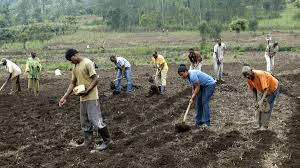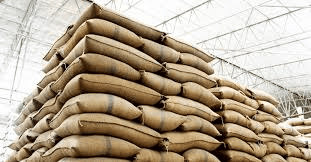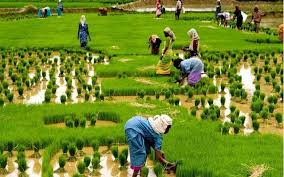Agriculture is one of the oldest and most essential activities in human history. It involves the cultivation of crops and the rearing of animals for food, fiber, medicinal plants, and other products used to sustain and enhance human life. Over thousands of years, agriculture has evolved, shaping societies, economies, and environments.
As the world population grows, agriculture continues to play a critical role in providing food security, supporting economic development, and improving livelihoods, particularly in rural areas.
Agriculture is not just about growing food; it includes practices like irrigation, fertilization, pest control, and harvesting. With advancements in technology, agriculture has become more efficient, allowing farmers to grow more food on less land.
However, despite its progress, agriculture faces challenges such as climate change, water scarcity, and the need for sustainable farming methods. Understanding the importance of agriculture is key to addressing these challenges and ensuring food security for future generations.
Agriculture as a Source of Food Supply
1. Primary Source of Food: Agriculture is the main source of food for the global population. Crops like rice, wheat, maize, and vegetables are staples in many diets, providing essential nutrients and calories for millions of people.
2. Livestock Production: In addition to crops, agriculture also involves raising animals for meat, dairy, eggs, and other products. Livestock farming supplies protein-rich foods that are essential for a balanced diet.
3. Ensuring Food Security: Agriculture is central to global food security, which means ensuring that everyone has access to sufficient, safe, and nutritious food. As the world population continues to grow, agriculture must increase its output while also addressing environmental sustainability and food distribution challenges.
4. Meeting Diverse Dietary Needs: Agriculture enables the production of a wide variety of foods, including fruits, vegetables, grains, and animal products, to meet the dietary needs and preferences of different populations. The diversity of crops ensures that people receive all necessary nutrients.
5. Reducing Hunger and Malnutrition: Through advancements in farming techniques and technology, agriculture has helped reduce hunger and malnutrition in many parts of the world. Improving food production methods can further help feed the growing global population.
Agriculture and Economic Development

1. Contribution to GDP: Agriculture is a major contributor to the Gross Domestic Product (GDP) of many countries, particularly in developing nations. In some regions, agriculture accounts for a significant portion of the national economy.
2. Income Generation: Agriculture provides income for millions of farmers, laborers, and traders involved in the agricultural supply chain. The sale of crops, livestock, and other agricultural products supports rural economies and improves livelihoods.
3. Export and Trade: Many countries rely on agriculture as a key export industry. Crops like coffee, cocoa, cotton, and tobacco are major exports for developing countries, contributing to national revenue and economic growth.
4. Raw Materials for Industry: Agriculture also supports other industries by providing raw materials. For example, crops like cotton and flax are used in the textile industry, while sugarcane and corn are used for biofuels and other industrial products.
5. Reducing Poverty: By providing employment and income opportunities, agriculture plays a critical role in reducing poverty in rural areas. It helps improve living standards and enables people to access education, healthcare, and other essential services.
Employment Opportunities in Agriculture
1. Farming and Cultivation: Agriculture provides direct employment to millions of people who work as farmers, laborers, and farm managers. These individuals are involved in planting, tending, and harvesting crops, as well as raising livestock.
2. Agribusiness: The agricultural sector includes various businesses that support farming activities, such as seed suppliers, fertilizer companies, machinery manufacturers, and food processing industries. These businesses create numerous jobs along the agricultural supply chain.
3. Agricultural Research and Development: Employment in agricultural research and development is essential for improving farming techniques, developing new crop varieties, and addressing challenges such as pests, diseases, and climate change. Scientists, agronomists, and researchers contribute to innovations in the sector.
4. Agricultural Education and Extension Services: Teachers, trainers, and agricultural extension officers play an important role in educating farmers about new technologies, sustainable practices, and efficient farming methods. These professionals help farmers increase productivity and adopt modern agricultural practices.
5. Marketing and Distribution: Agriculture also creates jobs in marketing, transportation, and distribution. People working in these fields ensure that agricultural products reach markets, both locally and internationally, and that food is available for consumers.
Read Also: The Health Benefits of Using Dukkah Seasoning on your Cooking
Agriculture and Rural Development

1. Improving Rural Livelihoods: Agriculture is the backbone of rural economies in many parts of the world. It provides employment, income, and food security, helping to lift rural communities out of poverty.
2. Infrastructure Development: Agriculture drives the development of infrastructure such as roads, storage facilities, irrigation systems, and markets in rural areas. Improved infrastructure helps farmers access markets, sell their products, and improve their livelihoods.
3. Access to Education and Healthcare: Through income generated from agriculture, rural families are able to afford education and healthcare, improving the overall quality of life. In many regions, agriculture is the key to better living standards in rural areas.
4. Empowering Women and Youth: Agriculture often provides opportunities for women and youth to engage in income-generating activities. Empowering these groups through farming initiatives can lead to greater economic independence and community development.
5. Sustainable Rural Development: Sustainable agricultural practices, such as crop rotation, organic farming, and water conservation, contribute to the long-term development of rural areas. These practices help maintain soil health, prevent environmental degradation, and ensure that future generations can continue farming.
Environmental Impact of Agriculture
Agriculture has both positive and negative effects on the environment. While it provides food, fiber, and raw materials for industries, it also contributes to environmental issues such as deforestation, soil degradation, water scarcity, and biodiversity loss.
1. Soil Degradation: Intensive farming practices, such as overuse of chemical fertilizers and pesticides, can deplete soil nutrients and lead to soil erosion. This reduces the land’s productivity over time.
2. Water Pollution: Agriculture is one of the largest users of freshwater. Excessive irrigation, along with the use of fertilizers and pesticides, can pollute rivers, lakes, and groundwater sources, affecting both human and aquatic life.
3. Greenhouse Gas Emissions: Agriculture contributes to climate change by releasing greenhouse gases like methane from livestock and nitrous oxide from fertilizer use. These gases contribute to global warming and climate instability.
4. Deforestation: Clearing forests to create farmland is a major driver of deforestation, especially in tropical regions. This leads to habitat loss for many species and reduces the Earth’s capacity to absorb carbon dioxide.
5. Biodiversity Loss: The expansion of monoculture farming (growing a single crop over a large area) reduces biodiversity by displacing native plants and animals. This makes ecosystems more vulnerable to pests and diseases.
Read Also: Where to Buy Blueberries
Agriculture and Global Trade

Global trade in agricultural products plays a significant role in the economy of many countries, particularly developing nations. Agriculture’s contribution to trade is crucial for food security, income generation, and economic growth.
1. Export of Agricultural Products: Many countries, especially developing ones, rely on agriculture as a key export sector. Crops like coffee, tea, cocoa, cotton, and sugar are major exports that generate revenue for countries involved in global trade.
2. Trade Agreements: Trade agreements between countries help facilitate the flow of agricultural goods across borders. These agreements can open up new markets for farmers, allowing them to sell their products globally.
3. Impact on Food Security: Global trade ensures that food can be distributed to regions where it’s most needed. Countries that experience food shortages due to climate change or other factors can import food to meet their needs.
4. Price Volatility: International trade can sometimes lead to price volatility. Global demand, currency fluctuations, and geopolitical tensions can affect the price of agricultural products, impacting both farmers and consumers.
5. Trade Barriers: Tariffs, quotas, and other trade restrictions can affect the competitiveness of agricultural products in the global market. These barriers can make it difficult for farmers to access new markets and reduce their income.
Role of Agriculture in National Security
Agriculture is a key factor in national security because it ensures food security, promotes economic stability, and supports the well-being of the population.
1. Food Security: A reliable agricultural sector ensures that a country can produce enough food to feed its population. Without sufficient food production, countries may become vulnerable to food shortages, leading to social unrest.
2. Economic Stability: Agriculture is often a major sector of the economy, particularly in developing countries. A stable agricultural sector provides jobs, income, and supports rural economies, contributing to national economic stability.
3. Rural Development: Agriculture helps develop rural areas by providing employment, infrastructure, and access to education and healthcare. Strong rural communities are less likely to experience poverty and instability, which can affect national security.
4. Energy Security: Agriculture also plays a role in energy security by producing biofuels such as ethanol and biodiesel. These renewable energy sources help reduce reliance on imported fossil fuels.
5. Disaster Resilience: A strong agricultural sector helps countries recover from natural disasters and other emergencies. Food reserves, robust farming practices, and local food production reduce dependency on external aid.
Innovations and Technology in Agriculture
Advances in technology are transforming agriculture, making it more efficient, productive, and sustainable. Innovations in agricultural technology help farmers optimize their operations, reduce costs, and increase yields.
1. Precision Farming: Precision farming uses data analytics, GPS, and satellite imagery to monitor crops and make more informed decisions about planting, irrigation, and fertilization. This technology helps farmers reduce waste and improve yields.
2. Drones and Sensors: Drones and sensors are used to monitor crop health, soil moisture, and pest infestations. These technologies allow farmers to take targeted actions, such as applying water or pesticides only where needed.
3. Genetic Engineering: Advances in genetic engineering have led to the development of crops that are resistant to pests, diseases, and drought. Genetically modified organisms (GMOs) can increase crop yields and reduce the need for chemical inputs.
4. Automation: Robots and automated machinery are increasingly used for planting, harvesting, and packaging crops. Automation reduces labor costs and allows farmers to manage larger farms more efficiently.
5. Artificial Intelligence (AI): AI is being used in agriculture to analyze large amounts of data, predict crop yields, and optimize farm operations. AI-powered systems help farmers make better decisions and improve productivity.
Sustainable Agriculture Practices
Sustainable agriculture aims to meet current food needs without compromising the ability of future generations to meet their own needs. Sustainable farming practices focus on environmental health, economic profitability, and social equity.
1. Crop Rotation: Crop rotation involves growing different crops in the same field in a planned sequence. This practice helps improve soil health, reduce pests and diseases, and increase crop yields.
2. Organic Farming: Organic farming avoids synthetic chemicals and relies on natural methods to improve soil fertility and control pests. Organic farming practices help maintain biodiversity and reduce environmental damage.
3. Conservation Tillage: Conservation tillage involves reducing the frequency of soil disturbance, which helps prevent soil erosion and improve water retention. This practice also reduces greenhouse gas emissions by keeping carbon in the soil.
4. Agroforestry: Agroforestry integrates trees and shrubs into agricultural landscapes. Trees provide shade, reduce wind erosion, improve water retention, and contribute to biodiversity, all while producing food, fuel, and other products.
5. Water Conservation: Sustainable agriculture uses water efficiently through methods such as drip irrigation, rainwater harvesting, and the use of drought-resistant crop varieties. Water conservation is essential in areas prone to water scarcity.
Agriculture and Climate Change
Climate change poses significant challenges to agriculture, but agriculture also has a role in mitigating its effects. Sustainable farming practices can reduce greenhouse gas emissions and help agriculture adapt to changing weather patterns.
1. Impact on Crop Yields: Climate change affects temperature, rainfall, and the frequency of extreme weather events, all of which impact crop yields. Some regions may experience reduced agricultural productivity, leading to food shortages.
2. Livestock and Climate Change: Livestock farming contributes to methane emissions, a potent greenhouse gas. Sustainable livestock practices, such as improved feed and manure management, can reduce emissions.
3. Carbon Sequestration: Agriculture can help mitigate climate change by capturing carbon in soils through practices like cover cropping, no-till farming, and agroforestry. These practices help reduce the amount of carbon dioxide in the atmosphere.
4. Drought and Water Scarcity: As climate change leads to more frequent droughts, agriculture must adapt by using water more efficiently. Drought-resistant crop varieties, efficient irrigation, and rainwater harvesting are critical to maintaining productivity in dry regions.
5. Reducing Food Waste: Reducing food waste at the farm level and throughout the supply chain helps lower the environmental impact of agriculture. Less food waste means fewer resources are used for food production, reducing the overall carbon footprint of agriculture.
Agriculture is a vital sector with far-reaching impacts on the environment, economy, and national security. Innovations in agricultural technology, sustainable farming practices, and government policies can help address the challenges posed by climate change, food security, and global trade.
By adopting sustainable practices and embracing new technologies, agriculture can continue to feed the growing global population while minimizing its environmental impact.
Do you have any questions, suggestions, or contributions? If so, please feel free to use the comment box below to share your thoughts. We also encourage you to kindly share this information with others who might benefit from it. Since we can’t reach everyone at once, we truly appreciate your help in spreading the word. Thank you so much for your support and for sharing!

